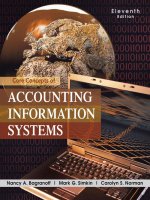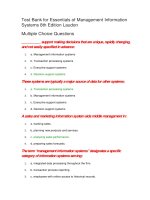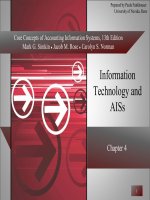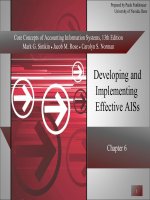TEST BANK CORE CONCEPTS OF ACCOUNTING INFORMATION SYSTEMS 13TH EDITION SIMKIN tb sa
Bạn đang xem bản rút gọn của tài liệu. Xem và tải ngay bản đầy đủ của tài liệu tại đây (72.84 KB, 10 trang )
Core Concepts of Accounting Information Systems, 13th Edition, by Simkin, Rose, and Norman
AIS - 13th Edition
TEST BANK KEY
Short Answer Questions
Chapter 1
109.
Some business activities that do not require traditional journal entries are: obtaining a line
of credit, issuing purchase requisitions or purchase orders, signing contracts, hiring a new
executive, and sending financial information to investors or bank loan personnel.
110.
Some reasons why XBRL formatted documents are useful include: they make financial
data more searchable, comparable, informative, and therefore useful, it enables
companies to use standard tags to identify specific accounting values, the language itself
imposes a greater degree of standardization in the informational content of the reports,
and XBRL also helps government agencies gather financial data that are more consistent,
easier to understand, self-checking, and more quickly communicated.
Chapter 2
136.
HTML stands for “hypertext markup language.” HTML is the editing language used to
display text, graphics, hyperlinks and similar information in web pages. HTML is nearly
universal in that it works no matter which browser you use. The language mostly uses
pairs of tags such as <b> and </b> to perform such tasks as bolding text.
137.
Electronic payments (E-payments) are payments that customers make to sellers
electronically. They are similar to credit card payments except that they use third parties.
One advantage of using such a system is that buyers need only provide their credit card
numbers or otherwise establish accounts once with the e-payment firm, instead of
repetitively with each vendor with whom they do business. Another major justification
for using E-payments is security. Credit-card information is at risk when it is transmitted
over data communications lines or stored in computer files of many vendors.
138.
Data encryption refers to transforming plaintext data into scrambled, cyphertext
messages that cannot be understood if it is intercepted during data transmission. Secret
key encryption relies upon a shared algorithm that must be kept secret to be secure.
Public key encryption uses two keys, a “private key” and a “public key,” both of which
must be known before a message can be decoded. This enables users to share a public
key, but retain the secrecy of a private key.
Short Answer Key – Page 1
Core Concepts of Accounting Information Systems, 13th Edition, by Simkin, Rose, and Norman
Chapter 3
88.
Hacking means gaining illegal or unauthorized access to computers, computer networks,
or computer files.
89.
A computer virus is a program or subroutine that can replicate itself in other programs or
computer systems.
90.
The idea that preventing cybercrime requires good policies and good education is based
on the fact that computer security requires commitment by top management to a set of
security policies that are understood and followed by employees. Employees must be
educated such that they are aware of the policies, understand how to follow them, and are
also able to recognize cybercrimes when they see them. Management must be committed
to these policies such that employees understand their importance and recognize the value
in helping to enforce the policies.
Chapter 4
140.
The components that make up an AIS system include: hardware, software, people, data
and procedures. A system is best viewed as a set of interacting components that must all
work together to accomplish data gathering, storage, processing, and output tasks.
141.
Processor speeds are rarely important to accounting systems because the speed of the
processor drastically exceeds the speeds for input and output operations. Most computers
are I/O bound, meaning that their CPUs mostly wait for data to be input or output.
142.
In centralized computing systems, the mainframe/host computer or minicomputer/host
performs most, if not all, of the processing and database tasks. In client/computing,
processing may be performed by the server computer or the client (typically, a
microcomputer), and database information is usually copied onto several file servers.
Chapter 5
102.
Data flow diagrams use a square symbol to show the source or destination of data. A
circle symbol indicates a process. An open rectangle symbol indicates a store of data.
Finally, arrows depict a data flow or data stream.
103.
Decision tables outline the set of conditions that a given processing task might encounter
and indicate the appropriate action to take for each condition. Decision tables therefore
help system designers plan data processing functions and create written documentation of
Short Answer Key – Page 2
Core Concepts of Accounting Information Systems, 13th Edition, by Simkin, Rose, and Norman
the processing logic for later reference. The major advantage of decision tables is that
they can summarize a potentially large number of conditions and actions in a compact
format. Decision tables are also useful as planning tools to system analysts,
programmers, and related individuals who plan and/or create new AISs. Finally, the
accountants who audit AISs rely heavily upon internal documentation, and decision tables
can help them verify the processing logic and control procedures built into these AISs.
104.
Process maps document business processes in easy-to-follow diagrams. Accountants and
managers can use this tool to help them describe current processes to others. Auditors
can use process maps to help them learn how a department or division operates,
document what they have learned, and identify internal control weaknesses or problems
in existing operations. An additional use of process maps is for training—for example, to
explain how complicated tax decisions are made. Finally, consultants frequently use
process maps to help them study business processes and redesign them for greater
productivity.
105.
End user documentation refers to the (often non-existent) user manuals, reference aides,
and similar materials that document the databases, spreadsheets, and other systems
created by non-IT personnel. If end users create the systems, then these developers
should also create the documentation for their models. End-user documentation is
important because such materials explain how systems work, identifies important inputs
and outputs, provides valuable insights into embedded controls, and helps others fix or
otherwise modify systems when the primary developers are no longer there.
Chapter 6
160.
The steering committee serves as an oversight committee that monitors the consultant’s
progress and critically reviews its systems analysis reports. These reports enable the
committee to consider the consultant’s findings and evaluate the solutions recommended
by its team members for solving current system problems.
161.
Several conditions when prototyping a system that should be used include: system users
do not understand their information needs very well, system requirements are difficult to
define and experimentation is easier with a live model, the system to be developed is
critical and needed quickly, past interactions have resulted in misunderstandings between
users and designers, design mistakes are costly, and the risks associated with developing
and implementing the wrong system are high
162.
PERT charts allow project leaders to achieve the following: (1) outline the full set of
activities that must be completed in a project, (2) identify precedence relationships, (3)
Short Answer Key – Page 3
Core Concepts of Accounting Information Systems, 13th Edition, by Simkin, Rose, and Norman
estimate the completion time of an entire project, (4) identify activities on and off critical
paths, and (5) examine “what-if” scenarios when project leaders contemplate reallocating
project resources from some activities to others.
Chapter 7
113.
Primary record keys (also called primary keys) are unique and are used to distinguish one
record from another. Secondary record keys are rarely unique, i.e., zip codes or last
names. Foreign record keys are used in databases to link the records in one database
table to records in other tables.
114.
An REA model in an AIS database stores information about these file entities—for
example: information about inventories (resources), cash sales (events), and customers
(agents). Two examples of such information mentioned in the text are “sales orders” and
“hiring decisions.” Similar information includes data about customer demographics,
interest rates, or competitor activities. Traditional accounting systems store data that
directly affect the financial statements of a company. For instance: sales, inventory, or
accounts payable.
115.
When a database is not normalized, use of the database can result in anomalies. Two
types of anomalies are update and delete anomalies. An update anomaly occurs when a
database user attempts to change information in the database, but data does not update
completely or accurately. For example, if the owner changed the description of an item
in the non-normalized database, the description would be changed for one instance of an
inventory item. But every inventory item and its description would be repeated for every
sale of that item. As a result, changing the description for one record in the database will
not change the description for every other instance of the same item, and the update of
the inventory description will not be complete. A delete anomaly occurs when one item
is deleted from the database, but other information is unintentionally lost. In this
example, a store clerk might delete an inventory item because the store no longer intends
to sell this item. However, deletion of the item could also cause the store to lose
information about customers if these customers had only purchased the item that is being
deleted. Because the customer information is stored with each sale (instead of being
stored in its own, normalized table), deletion of items can result in the permanent loss of
information about the customers who purchased those items.
Chapter 8
102.
A database is a collection of tables with individual fields that identify each item (e.g.,
customer number, customer name, credit limit, etc.) and then relates the tables in order to
query and write reports. A DBMS is a set of software programs that interfaces between
the database and users or user programs.
Short Answer Key – Page 4
Core Concepts of Accounting Information Systems, 13th Edition, by Simkin, Rose, and Norman
103.
The schema of a database is an overall plan for storing information in the tables of a
database (e.g., the data it contains and the relationships among them). In contrast, a
subschema is a subset of this data (often, a particular user’s view). Subschemas focus on
the informational needs of specific users, and limit access to sensitive data. Thus, the
subschema is on a need to know basis.
104.
There are many ways that data mining could change the accounting profession. Some
examples from the text include the ability of auditors to conduct new tests that look for
fraud, identification of firms that could go bankrupt by examining the text of MD&A
disclosures, discovery of credit card fraud by looking for anomalies in credit card
use, and discovering fraudsters by analyzing corporate emails. Data mining is already
used extensively in marketing, and there is a growing interest, particularly in the audit
area, in using data mining to find patterns in data that could reveal errors and fraud.
Chapter 9
63.
Subforms are handy for showing subordinate information and they also allow users to
enter data at the time the form and subform display—a handy feature if the user wishes to
create new records in the subform.
64.
Reasons for designing the layout for a report prior to creating the report include the
usefulness of (1) identifying what information to include, or to omit, from a potentially
large set of items, (2) deciding how to best make use of the limited “real estate” of an
output page, and (3) grouping data in useful ways to best compute subtotals or other
statistical outputs. This is a good opportunity to remind students that the purpose of most
AISs is to provide meaningful, decision-oriented information to users—not simply to
create “pretty” reports.
65.
A report based on a table simply displays the data (or calculated values) from a single
underlying table. A report based on a query can be based on multiple tables, can also
include calculated fields, and of course, will display the information for only those
records satisfying the query itself. For example, a report based on query might limit the
output to those students who live in dorms.
66.
Controls on forms (such as drop down lists) are often designed to prevent data entry
errors and to help users input data more accurately and efficiently. These controls affect
only the specific form being used. For example, a drop down list of states controls only
the data entry of states and only when the form with the control is used to enter this data.
Controls within database tables are more pervasive and provide control over the data that
enters the tables regardless of which form is used and regardless of whether a form is
used. These controls often involve validation rules and data type settings. Controls
within the tables themselves provide for more wide-ranging protection of the integrity of
the data in the database.
Short Answer Key – Page 5
Core Concepts of Accounting Information Systems, 13th Edition, by Simkin, Rose, and Norman
Chapter 10
63.
Chapter 7 discussed a number of purposes. Among the uses of accounting codes are the
following: to uniquely identify accounting data (more than one person or product may
have the same name), to compress data (written descriptions are generally much longer
than a code), to classify data (codes facilitate classification either manually or
electronically), and to convey special meanings (codes can be used to indicate such things
as credit ratings, credit limits, prices, or passwords).
64.
Data flow diagrams are logical descriptions of a system whereas systems flowcharts
capture a physical view of the system. The data flow diagram would show processes,
similarly to a systems flowchart. The systems flowchart, however, is likely to show
whether the processes are performed by computer, manually, or by another device. Flow
lines in the data flow diagram would show input and output items. These would either go
to a data source or destination or a data store. The flowchart would show inputs and
outputs apart from flow lines. They might be depicted in manual files, disk files, tape
files, documents, etc. Both flowcharts and data flow diagrams may be designed to show
increasing levels of detail. For instance, a context data flow diagram corresponds to a
high level systems flowchart and each usually shows only one overall process for the
revenue cycle.
65.
Offshoring means that companies have outsourced one or more business functions
(processes) to companies that are not located in the US. According to a recent META
Group report (www.metagroup.com, Worldwide IT Benchmark Report, 2004), India
continues to be the preferred offshore country with more than 500,000 knowledge
workers. Other countries compete with India for this offshore business – such as Russia,
the Philippines, Ireland, Israel, and China.
Chapter 11
69.
Two reasons students may give are that outside service bureaus may be less expensive for
payroll processing and that an outside service may be advantageous in terms of
confidentiality.
70.
Some "roots" of lean practices include: Consolidating production steps, having raw
materials set up at hand to save time and increase productivity, moving equipment to
make production flow smoother, and finishing a product in one space rather than walking
to another room for finishing.
Short Answer Key – Page 6
Core Concepts of Accounting Information Systems, 13th Edition, by Simkin, Rose, and Norman
71.
Students will come up with a variety of answers to this question. Some vertical market
industries include: insurance (different insurance needs and fraud), banking (check
clearing, credit ratings, credit histories, and financial markets), construction (job costing
and bidding capabilities), manufacturing (inventory control), retail (POS systems and
analyzing sales), hospitality (monitoring costs, perishable inventory), and government
organizations (fund accounting and governmental accounting standards
Chapter 12
119.
Accounting software is integrated when (1) it contains various modules such as general
ledger, accounts receivable, and accounts payable, and (2) inputs and outputs to and from
these modules to interact with one another seamlessly and without outside intervention.
Lacking integration, users must transfer data from one system to another manually—a
time-consuming, error-prone process that seems antiquated today.
120.
All integrated accounting software packages are not alike. They differ in many ways,
including: (1) the number and types of modules included or available, (2) the
sophistication and complexity of the basic general ledger application, (3) the type of
company supported (e.g., niche company such as a car-rental agency versus a
manufacturing facility), (4) price, (5) the number of simultaneous online users supported,
(6) ability to interface with other, non-accounting software, (7) availability of online,
cloud hosting, (8) scalability, and (9) various specialized capabilities (e.g., cloudprocessing capabilities, or the ability to work with different currencies).
121.
The textbook mentions five major cloud services: (1) anytime, anywhere access to
accounting information from a variety of Internet access devices, (2) automatic storage
and backup of important accounting data, (3) multiuser access (perhaps from different
remote locations), (4) automatic upgrades to newer versions of the software, and (5) the
ability to print reports directly from host data sources.
122.
ERP systems offer flexibility and customization capabilities. They may also allow for
features such as "user-defined codes." These are extra fields that users can designate to
meet the special needs of a particular business. Another feature of high-end software is
that it typically has more reporting capabilities.
123.
Sadly, no ERP system appears to be too big to fail, although most companies wish
otherwise. Figure 12-8 in the chapter provides four, multi-million dollar examples.
These illustrations point to the importance of advanced planning, careful implementation,
and delicate change management when acquiring and installing such systems.
Short Answer Key – Page 7
Core Concepts of Accounting Information Systems, 13th Edition, by Simkin, Rose, and Norman
124.
Some of the consequences of bad decisions when acquiring a new accounting information
system are wasted financial investments and wasted time. Also, when trying to “make it
work,” employees are likely to become frustrated, discouraged, or adversarial, managers
will not have the information they need, and outside parties such as suppliers and
investors may be inconvenienced. In the worst-case scenario, a company may have
trouble managing its inventories, paying its bills, collecting on accounts receivable,
managing cash flows, reporting net income, and meeting payroll deadlines.
Chapter 13
89.
COSO stands for Committee of Sponsoring Organizations. COBIT stands for Control
Objectives for Information and Related Technology.
90.
Preventive control procedures are designed and implemented before an activity is
performed to prevent some potential problem (e.g., the inaccurate handling of cash
receipts) from occurring that relates to the activity. Detective control procedures are
designed and implemented to provide feedback to management regarding whether or not
operational efficiency and adherence to prescribed managerial policies have been
achieved. In other words, preventive controls should be developed prior to operating
activities taking place and detective controls should be developed to evaluate if operating
efficiency and adherence to policies of management have occurred after operating
activities have taken place. Corrective control procedures come into play based on the
findings from the detective control procedures. That is, through detective controls,
corrective control procedures should be developed to identify the cause of an
organization’s problem, correct any difficulties or errors resulting from the problem, and
modify the organization’s processing system so that future occurrences of the problem
will hopefully be eliminated or at least minimized.
Examples of each type of control are as follows:
Preventive: scenario planning, risk management, segregation of duties, controlling
access to assets
Detective:
duplicate check of calculations, bank reconciliations, monthly trial
balances
Corrective:
backup copies of transactions and master files, training personnel to
perform their jobs
Chapter 14
Short Answer Key – Page 8
Core Concepts of Accounting Information Systems, 13th Edition, by Simkin, Rose, and Norman
118.
Business continuity planning (BCP) is also called contingency planning and disaster
planning. A business continuity plan is necessary because a variety of unforeseen
disasters might occur that would cause a data processing center to not be operational.
Examples of these disasters include natural events such as fires, floods, hurricanes,
earthquakes, and manmade catastrophes such as terrorist attacks.
119.
The concept of convergence of physical and logical security means that an organization
has integrated these two forms of security. Thus, incidents that might individually go
unnoticed do not go undetected when they are combined. Restrictions on physical access
protect the physical assets of the computer system and the data processing center.
Restrictions on logical access safeguard computer time and maintain the privacy of the
data files available to remote users. The combination of these two forms of security can
make an organization less vulnerable to embezzlement or fraud.
120.
The separation of duties control is intended to deter an individual from committing an
intentional accounting error and concealing this error in the normal course of his or her
duties. To the extent that computerized accounting systems will handle functions that
would be performed by more than one person under a manual system, the computerized
version of the accounting information system cannot entirely adhere to this policy of
separate responsibilities for related accounting processing functions. A computerized
accounting information system will tend to combine certain traditionally separated
accounting tasks in its data processing, but use alternate means for the application of the
separation of duties control.
Chapter 15
85.
Section 404 of the Sarbanes Oxley (SOX) Act will likely add more cost to an audit.
Section 404 requires management in public companies to establish and maintain an
adequate internal control system and appropriate procedures for financial reporting. The
annual report must include an assessment of this system and the procedures. Finally, the
external auditor must attest to and report on management’s statements and assertions.
86.
Some techniques and skills that would be helpful to an interviewer would include:
session planning, interview structuring, understanding the use of various question
formats, options for controlling and documenting an interview, and, perhaps most
important – how to listen.
87.
Continuous auditing is the real-time assurance of accounting disclosures. There is
increased demand for continuous auditing because many businesses now report some
information in real time using the Internet and stakeholders want more timely
information. There are five main continuous auditing techniques. (1) Embedded audit
modules are application subroutines that capture data related to high-risk areas and save
these data in logs for auditors to review. (2) Exception reporting allows the system to
Short Answer Key – Page 9
Core Concepts of Accounting Information Systems, 13th Edition, by Simkin, Rose, and Norman
continually monitor itself by reporting exception transactions. Exception transactions are
transactions that fall outside predefined specifications and are rejected by the system,
such as an unusually large payment to a vendor. (3) Transaction tagging allows auditors
to tag transactions with special identifiers such that the transactions can be traced through
processing steps in the AIS and logged for review. (4) The snapshot technique involves
marking transactions with code that triggers a snapshot process. Snapshot data are
recorded in a special file and reviewed by the auditor to verify that all processing steps
have been properly performed. (5) Continuous and intermittent simulation (CIS) embeds
an audit module in a database management system (DBMS). The CIS module examines
all transactions that update the DBMS and can independently process the data and
compare to results obtained by the DBMS.
Short Answer Key – Page 10









